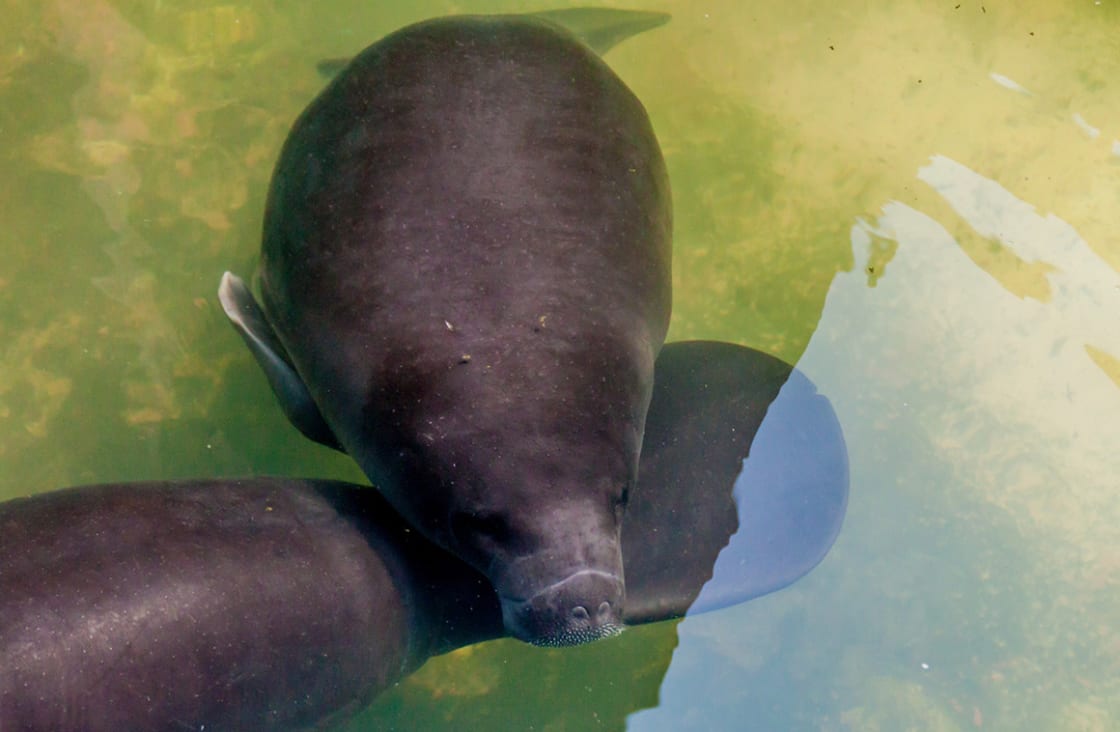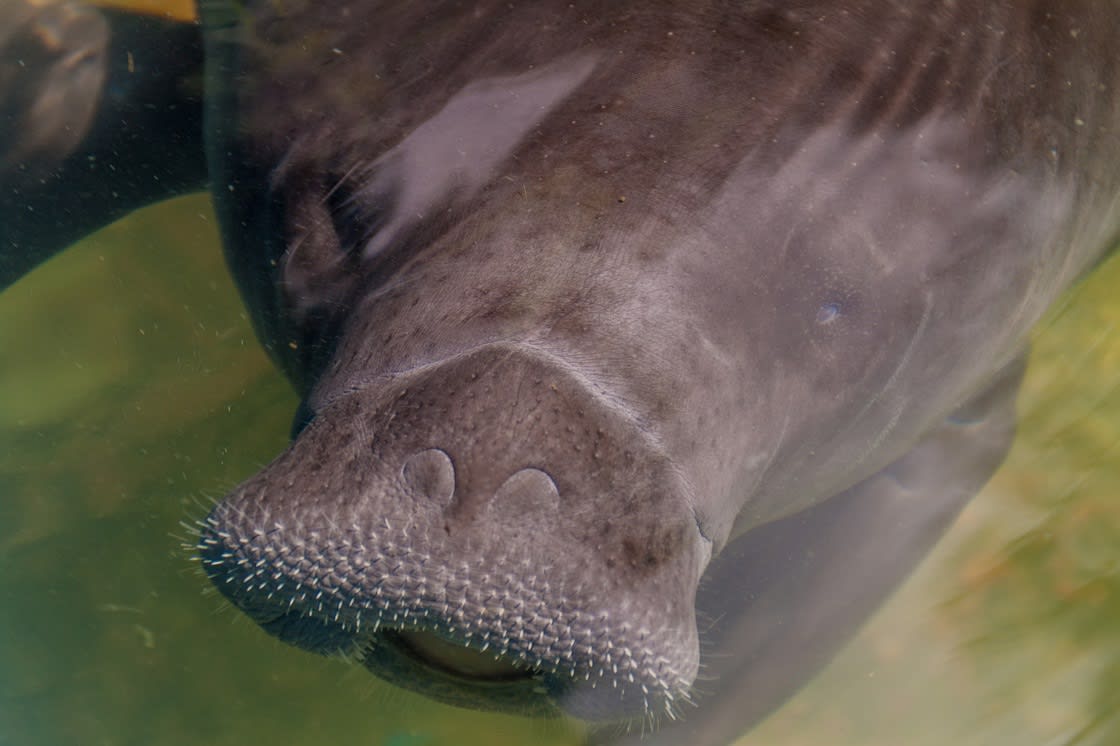
Found in the freshwater habitats of the Amazon basin, the Amazonian manatee is one of the many fascinating aquatic mammals that call the waters of the Amazon it’s home. Curious in appearance, the Amazonian manatee was first described as a combination between a hippopotamus and seal… if you can imagine that. The smallest of all manatee species, the Amazonian manatee is more slender than its relatives, with seal-like flippers for arms and a rounded paddle-shaped bottom to help it swim.
These gentle animals, also lovingly called “sea cows”, have unfortunately been classified as Vulnerable on the Appendix of Endangered Species, and their home in the murky Amazon waters has made it difficult for researchers to estimate exactly how many manatees are left in the Amazon. Luckily, there are many organizations that have begun to work together to rehabilitate these endangered animals in the Amazon, and thanks in part to their help it is still possible to see quite a few manatees in their natural habitat in Peru, Brazil, Bolivia, Colombia and Ecuador. Read on for our favorite Amazonian manatee facts, some conservation initiatives underway for them, and how you can responsibly see manatees in the Amazon for yourself.

Amazonian Manatee
1. Size: Amazonian Manatees can be up to 2.8 meters long (almost 9 feet), and weigh between 350 and 500 kg (770-1,100 lbs).
2. Names: The Amazonian manatee is also referred to as a sea cow, South American manatee, and peixe-boi (in Brazil).
3. Amazonian manatees have marching teeth: A unique feature amongst all mammals is that manatees have constant replacement of molar teeth, also known as “marching molars”. New teeth consistently enter at the back of the mouth, replacing old and worn-out teeth in the front.
4. Amazonian manatees may have a 6th Sense: If you’ve seen a close-up photo of a manatee, you’ve probably noticed the endearing whiskers all over their snouts. Recent evidence is suggesting that manatees have a 6th sense, enabling them to detect pressures changes through such sensory hairs!
5. Amazonian manatees also have great eyesight and hearing: Despite very small eyes, a surprising manatee fact is that they can see very well- they even have a membrane that can be drawn across their eyeballs for protection. Their hearing is also great, even though they have no outer ear structures (they have large inner ear bones).
6. Amazonian manatees are shy eaters: Amazonian manatees are one of only four species total that are plant-eating marine animals (3 manatee species and the similar dugong). Since they live almost entirely underwater, eating involves secretively raising just their nostrils above the surface as they search for vegetation near lake edges.
7. Amazonian manatees eat a TON: Even though their eating is done secretively and slowly, manatees can eat up to 8% of their body weight each day!
8. But, they can go months without eating: A surprising fact considering their potential food intake, but manatees can go months without food! The reason manatees feed so heavily during raining months is to store food for the dry season when there is a lack of accessible vegetation. During this time they’ll hide in flooded backwaters with their herd, sometimes without eating for weeks or months at a time.
9. Mothers and babies manatees have a very close bond: Mothers only give birth to one calf at a time, usually after carrying the baby for about 13 months! The babies remain dependent on the mother for quite some time, so mothers often wait as long as 3.5 years before having another baby.
10. Amazonian manatees are usually found in small groups: Once known to live in large herds, manatees now are found individually or in small groups of just four to eight.
Amazonian manatees aren’t yet an endangered species of the Amazon – but they’re close. According to Appendix I of CITES, the Amazonian manatee is classified as Vulnerable on the IUCN Red List, one step before endangered (many incorrectly call them an endangered species). Populations of manatees in the Amazon are expected to decline by as much as 30 percent over the next 20 years. And unfortunately, we don’t know exactly how many are left. As mentioned above, these manatees live in murky waters that make it very challenging to know how exactly many remain in the wild.
Manatees in the Amazon have long suffered from extensive hunting for their meat, oil, and fat, both by commercial hunters and locals in the Amazon who use the animals for personal use. At one time, the animal was hunted for its hide, in demand for use as water hoses and machine belts.
The biggest threats to Amazonian manatees now include hunting and accidental drowning in commercial fishing nets. International trade of the Amazonian manatee is now prohibited, although it has been very difficult to control hunting for meat in these poorer areas. The manatee’s food supplies are also decreasing as the areas surrounding their river habitats suffer from deforestation and subsequent soil erosion.

Manatees Being Fed By Hand In The Manatee Rescue Center, In Iquitos – Peru
Luckily, the manatees listing as Vulnerable has helped protect the species, and several reputable organizations have begun conservation projects. One of the most successful rescue projects is the Manatee Rescue Center in Iquitos, Peru, which has committed itself to rescuing and rehabilitating orphaned Amazonian manatees in addition to providing an environmental education program.
This manatee rescue center in the heart of the Amazon has been an incredible new implementation, for the manatee population and tourists alike. By offering daily tours, the rescue center raises money while educating the public, and visitors get a chance to learn about the rare animals and responsibly interact with them.
While Rainforest Cruises aim to provide accurate and up-to-date information, we make no representations as to the accuracy or completeness of any information herein or found by following any link on this site. Rainforest Cruises cannot and will not accept responsibility for any omissions or inaccuracies, or for any consequences arising therefrom, including any losses, injuries, or damages resulting from the display or use of this information.




